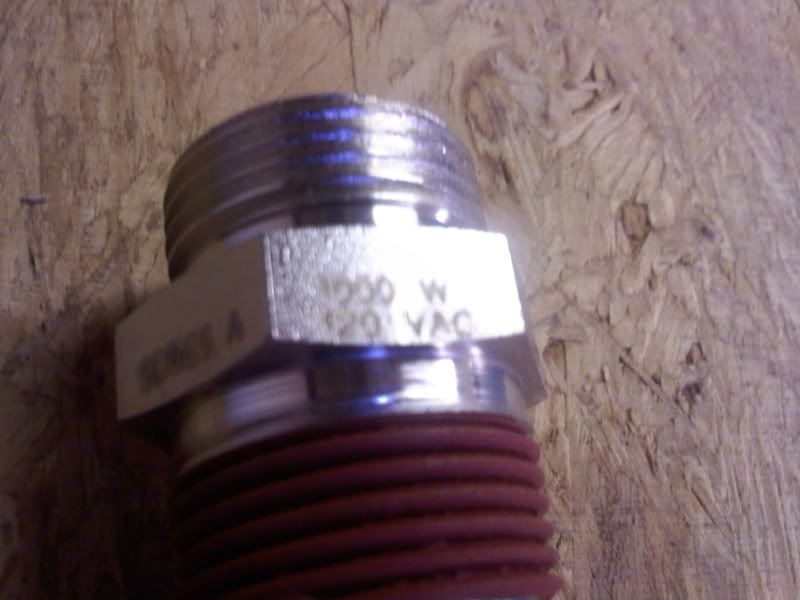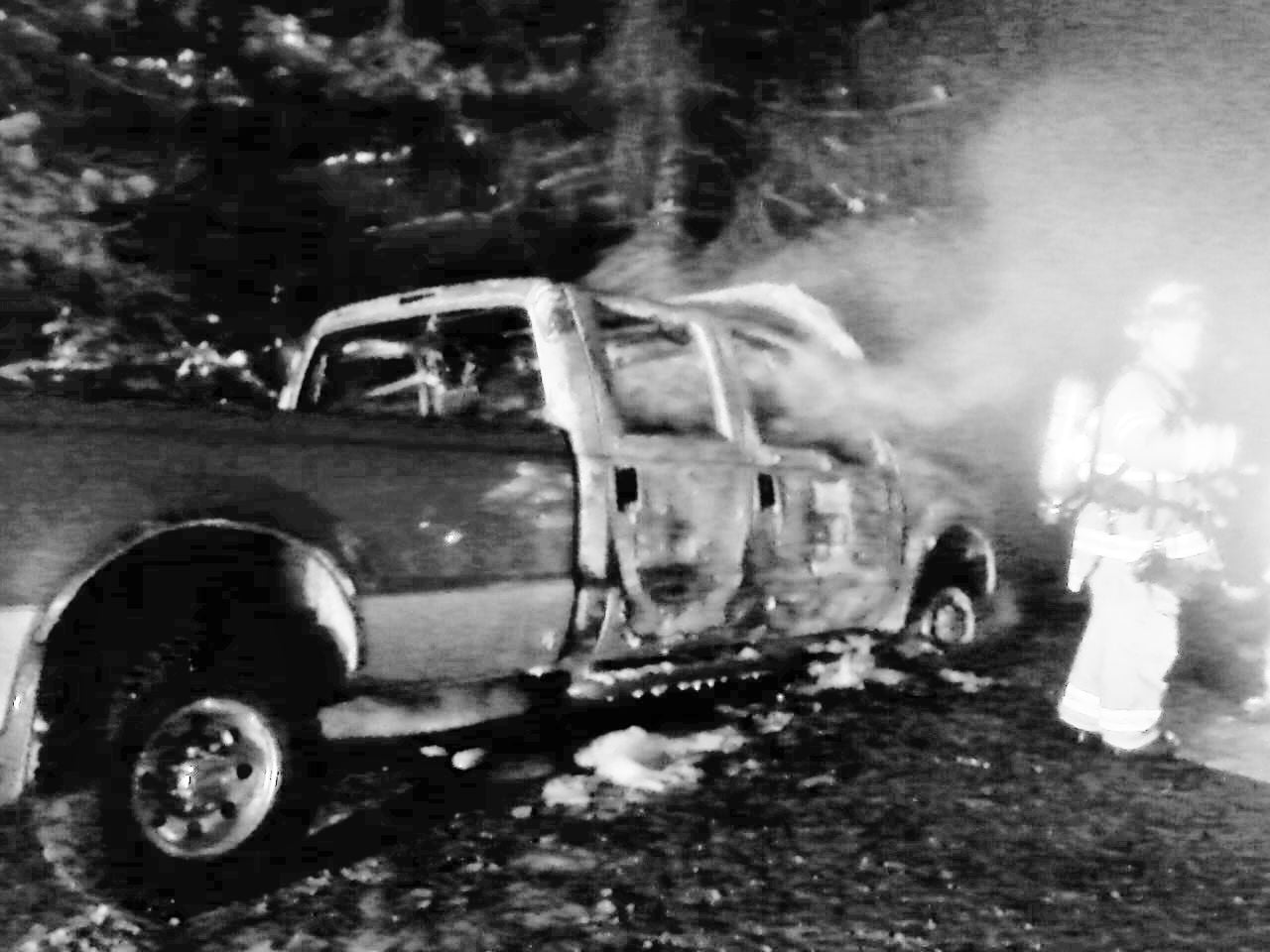2001 F250 caught fire after plugging in (pics)
#46
Of course all electrical cords and connectors should be routinely inspected for degradation and no form of "protection" is absolutely "foolproof" but a stand-alone 15 Amp "GFCI breaker" would be the best "practical" choice for protection against both "overload" and "electrocution" because 15 Amps is the closest match to the 8 Amp load current of the PSD coolant heater so a breaker with a 15 Amp rating is more "sensitive" to an overload than one with a higher current rating. Also if the coolant heater element should develop an internal short circuit a properly functioning 15 Amp breaker will limit the maximum current in the extension cord to a value that won't overheat the cord!
As is mentioned in the reference below from which I've copied and pasted several comments... combustion requires both heat and fuel and the fuel for a fire usually comes from some nearby material ...and having the PSD electrical cord run from the front bumper to the coolant heater connection near the oil filter isn't a good approach because this path "potentially" allows both fuel and oil to drip onto the cord and any fire that might develop is directly under the engine! The easiest fix might be to enclose this entire run in a metallic electrical conduit! On my Freightliner the electrical cord runs from a "waterproof" connector on the driver's side step to the side of the block and the path of the cord is fairly well separated from any combustible materials!
Tests and measurements for electrical fire prevention... http://support.fluke.com/find-sales/...519680_a_w.pdf
If a load draws too much current, the system components upstream of the load have to carry that current. The main protection against overload is the overcurrent protection device which should open. If it does not open, the high current will cause overheating distributed along the portion of the system upstream of the excessive load.
Combustion requires both heat and fuel. The fuel for the fire usually comes from some nearby material, with the electrical system providing the heat required for ignition. All terminals and splices are potential candidates for overheating, although the more current a connection carries, the more critical it is to maintain low resistance. If a poor connection is allowed to persist, oxides will build up on the connection interface, causing the resistance to increase. Ultimately this can result in what is called a “glowing connection”, which can generate significant heat without tripping protection devices.
The most extreme form of insulation failure is a short circuit. In this case, two conductors make contact and remain in contact. The resulting overcurrent should cause a fuse or circuit breaker to open. But if the overcurrent protection device fails to open, the circuit upstream of the short circuit will be subject to overheating. If there’s a ground fault (a short circuit involving an equipment ground), then the breaker should also open. If it doesn’t, the same overheating arises. If there’s a resistive connection in the bonding system that limits the current, the resulting current may not be sufficient to trip the upstream protection devices but may still cause heating in the bonding system.
Parallel arcing occurs when two connectors come close, or touch and part. It has similar characteristics to series arcing (above) but tends to involve higher currents. This can cause ignition of a nearby fuel source or further degradation of the insulation. Arcing can discharge hot metal sparks that can ignite a nearby fuel source. If insulation is subjected to the heat of other failures, the surface of the insulation can char and become conductive. A phenomenon called arc tracking can result, causing intense localized heating similar to other arcing.
As is mentioned in the reference below from which I've copied and pasted several comments... combustion requires both heat and fuel and the fuel for a fire usually comes from some nearby material ...and having the PSD electrical cord run from the front bumper to the coolant heater connection near the oil filter isn't a good approach because this path "potentially" allows both fuel and oil to drip onto the cord and any fire that might develop is directly under the engine! The easiest fix might be to enclose this entire run in a metallic electrical conduit! On my Freightliner the electrical cord runs from a "waterproof" connector on the driver's side step to the side of the block and the path of the cord is fairly well separated from any combustible materials!
Tests and measurements for electrical fire prevention... http://support.fluke.com/find-sales/...519680_a_w.pdf
If a load draws too much current, the system components upstream of the load have to carry that current. The main protection against overload is the overcurrent protection device which should open. If it does not open, the high current will cause overheating distributed along the portion of the system upstream of the excessive load.
Combustion requires both heat and fuel. The fuel for the fire usually comes from some nearby material, with the electrical system providing the heat required for ignition. All terminals and splices are potential candidates for overheating, although the more current a connection carries, the more critical it is to maintain low resistance. If a poor connection is allowed to persist, oxides will build up on the connection interface, causing the resistance to increase. Ultimately this can result in what is called a “glowing connection”, which can generate significant heat without tripping protection devices.
The most extreme form of insulation failure is a short circuit. In this case, two conductors make contact and remain in contact. The resulting overcurrent should cause a fuse or circuit breaker to open. But if the overcurrent protection device fails to open, the circuit upstream of the short circuit will be subject to overheating. If there’s a ground fault (a short circuit involving an equipment ground), then the breaker should also open. If it doesn’t, the same overheating arises. If there’s a resistive connection in the bonding system that limits the current, the resulting current may not be sufficient to trip the upstream protection devices but may still cause heating in the bonding system.
Parallel arcing occurs when two connectors come close, or touch and part. It has similar characteristics to series arcing (above) but tends to involve higher currents. This can cause ignition of a nearby fuel source or further degradation of the insulation. Arcing can discharge hot metal sparks that can ignite a nearby fuel source. If insulation is subjected to the heat of other failures, the surface of the insulation can char and become conductive. A phenomenon called arc tracking can result, causing intense localized heating similar to other arcing.
#47
#48
The mod linked to below is one that might help prevent these types of fires and since this mod requires cutting off the OEM bumper plug anyway this would be a good time to slip a flexible wire mesh sheath over the entire run of cord all the way back to the connection at the heater element. Leave enough length on the bumper end to solder a wire to this sheath and after the solder joint cools slip this part of the sheath over the cord and connect this soldered on wire along with the green wire in the OEM cord to the ground lug in the new 3 prong waterproof connector mounted on the bumper!
I haven't personally checked this out but on the OEM flat cord there should be a green wire and a small ridge running alongside one of the other two wires to identify it as the hot wire and then the remaining wire is the neutral wire and about 4" from where you cut off the OEM bumper plug this neutral wire should have some small white lettering that says "neutral"! Having a grounded wire mesh sheath over the entire run of cord will increase the likelihood that any bare wires that might develop due to damage from "road debris" or "animal bites" will contact ground and trip the breaker as soon as you plug in the truck!
I use an outside GFCI protected receptacle that has its own stand-alone breaker to plug my truck into. I never plug my truck into any of the sometimes more conveniently located exterior GFCI protected receptacles on my 5er because if my coolant heater shorts out the resulting high current overload will be applied to the AC wiring leading to my interior breaker box and if the breaker there fries itself and fails to trip I'll damage the "inaccessible" AC wiring in my 5er and might even set it on fire!
Marinco Block Heater Plug Mod for PSDs... It's really waterproof so it won't get corroded... TheDieselStop.Com - www.thedieselstop.com
I haven't personally checked this out but on the OEM flat cord there should be a green wire and a small ridge running alongside one of the other two wires to identify it as the hot wire and then the remaining wire is the neutral wire and about 4" from where you cut off the OEM bumper plug this neutral wire should have some small white lettering that says "neutral"! Having a grounded wire mesh sheath over the entire run of cord will increase the likelihood that any bare wires that might develop due to damage from "road debris" or "animal bites" will contact ground and trip the breaker as soon as you plug in the truck!
I use an outside GFCI protected receptacle that has its own stand-alone breaker to plug my truck into. I never plug my truck into any of the sometimes more conveniently located exterior GFCI protected receptacles on my 5er because if my coolant heater shorts out the resulting high current overload will be applied to the AC wiring leading to my interior breaker box and if the breaker there fries itself and fails to trip I'll damage the "inaccessible" AC wiring in my 5er and might even set it on fire!
Marinco Block Heater Plug Mod for PSDs... It's really waterproof so it won't get corroded... TheDieselStop.Com - www.thedieselstop.com
#50
Please feel free to send me email at... kempegenek@ernesteugene.com ...where as you can see I've managed to include all my various names.
Also welcome to FTE... and I'm "pleased" to be the subject of a "favorable first post" for a change but that's an "inside joke" that I won't bother to explain or link to for those who don't already get it!
On a business note... in the "mod link" I gave previously the link to the "auto eject" plug option doesn't work so for those forgetful types who drive off without "manually" disconnecting their plug ...here's a link to the "auto eject" plug that does work... Kussmaul Electronics Co., Inc. Super Auto Eject Data Sheet
#51
I got a call from the fire department friday night, and rushed down to the shop to find this...
2001 F250 w/ 353,000 miles.
The story/theory: It was plugged in, like any other truck around our shop, so it would be warm the next morning. We can't be sure it was the block heater or the cord or anything related, but it looks that way. Just wanted to share so others could check their cords for any wear/tear that might lead to something like this.
Moment of silence please...
<CENTER>
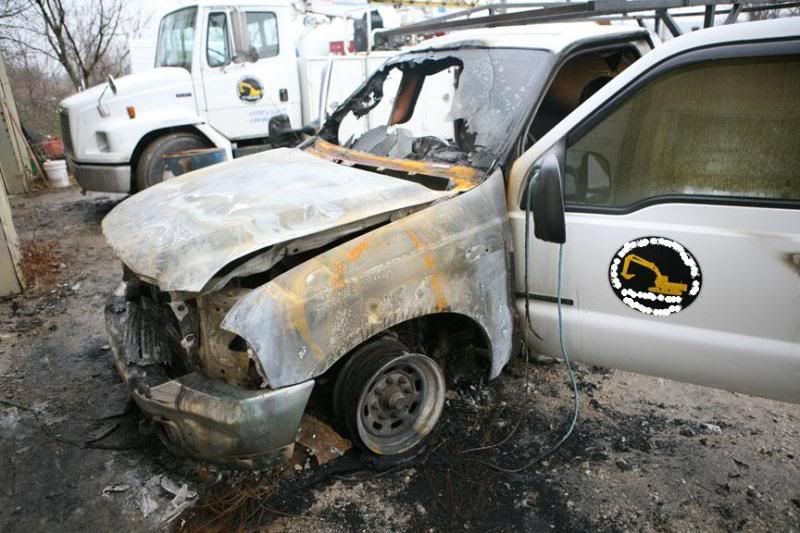
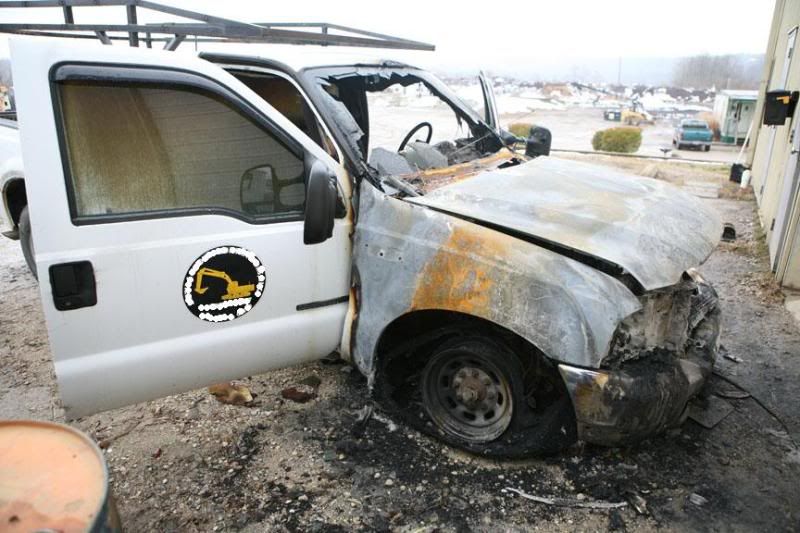
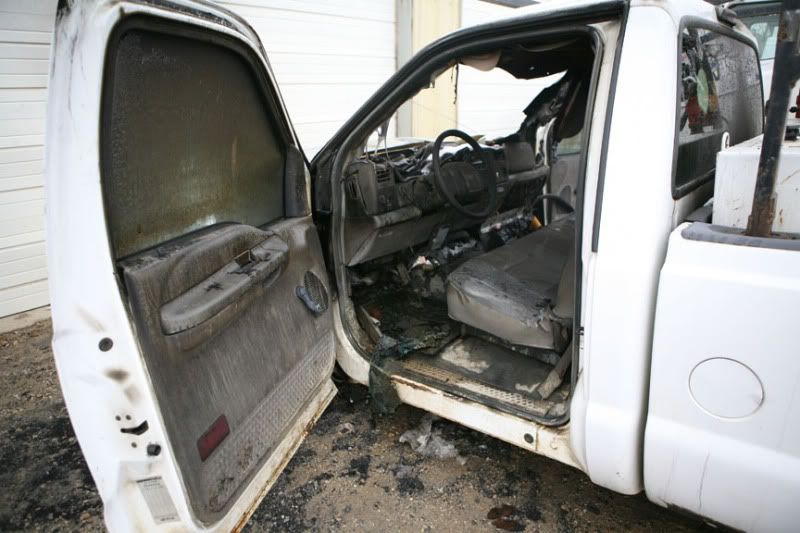
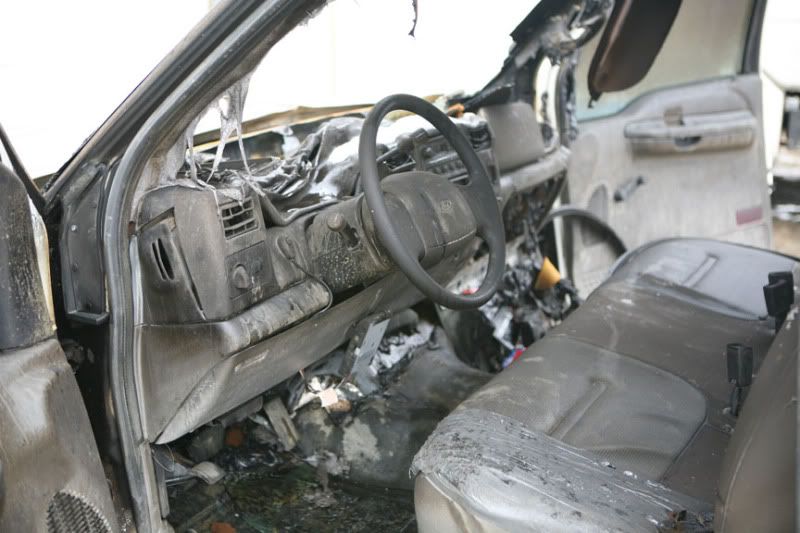
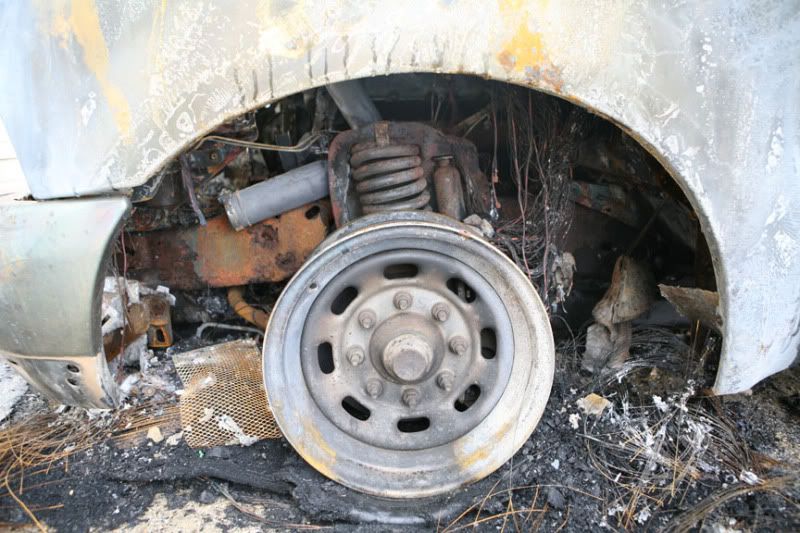
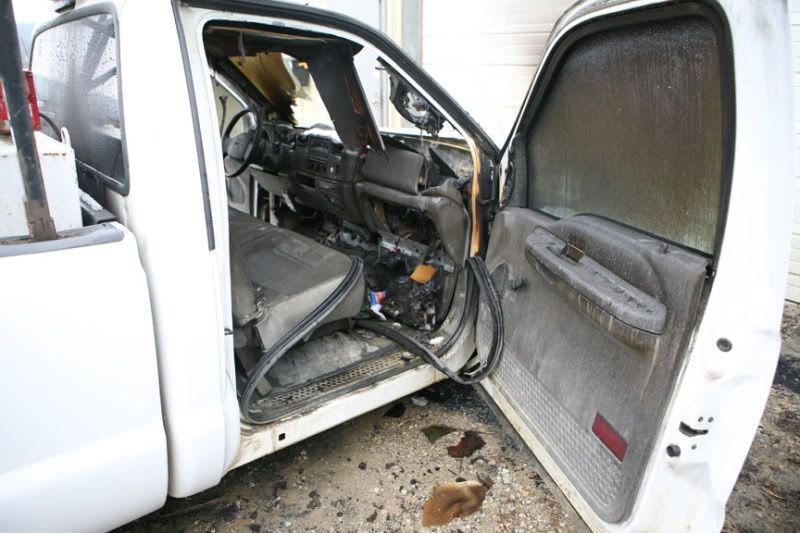
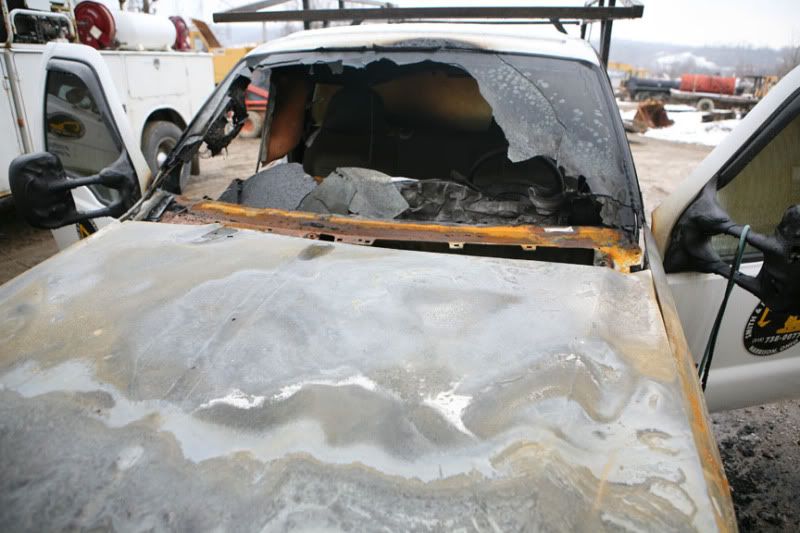
</CENTER>
2001 F250 w/ 353,000 miles.
The story/theory: It was plugged in, like any other truck around our shop, so it would be warm the next morning. We can't be sure it was the block heater or the cord or anything related, but it looks that way. Just wanted to share so others could check their cords for any wear/tear that might lead to something like this.
Moment of silence please...

<CENTER>







</CENTER>
[/quote]
Sorry for your loss, moment of silence observed.
A GFCI will only trip if it doesn't see all the current passing through it returning on the neutral, for instance if some of the return current found another path like a person etc. A GFCI does not provide overcurrent protection, that is the circuit breakers job.
You couldn't really test with an ohmeter because the meter does not put enough of a load on the wire to expose the problem. A megger might expose it.
If the condition exists in your cord and plug you can most likely spot it by closely examining the plug end for signs of overheating right where the prongs are set into the molded part, to see if it got hot. Also where the cord enters the plug end, the wire should be nice and firm and should not flop around.
I think anyone who is worried about it should first inspect the entire cord, then do the Marinco mod to elimiate the cord end.
TheDieselStop.Com - www.thedieselstop.com
The link shows it installed on the plastic air dam, but I installed mine higher up in the actual bumper. The bumper can be easily and cleanly punched with a 1.5" electricians knockout punch.
You couldn't really test with an ohmeter because the meter does not put enough of a load on the wire to expose the problem. A megger might expose it.
If the condition exists in your cord and plug you can most likely spot it by closely examining the plug end for signs of overheating right where the prongs are set into the molded part, to see if it got hot. Also where the cord enters the plug end, the wire should be nice and firm and should not flop around.
I think anyone who is worried about it should first inspect the entire cord, then do the Marinco mod to elimiate the cord end.
TheDieselStop.Com - www.thedieselstop.com
The link shows it installed on the plastic air dam, but I installed mine higher up in the actual bumper. The bumper can be easily and cleanly punched with a 1.5" electricians knockout punch.
Great explanation of how the GFCI works and how to inspect the cord. I'll be doing the Marinco plug mod soon too, I use the plug in regularly in the winter. Only thing I'll correct you on is the hole size needed for the plug, the last one I helped install(Jay, "dieselcamper01") used a 1 7/8" hole size.
I use a timer on the outlet that plugs into the cord going to the block heater. I set it about 2 hours earlier than I'll usually use the truck and have it set to shut off an hour after I would normally start the truck. That helps reduce the chance of something happening and also saves money. The only drawback is if I need the truck earlier and it is real cold I may have a start problem.
#52
#53
According to this Grainger page:
http://www.grainger.com/Grainger/items/4A740
a 1-1/2" electricians knockout punch would be 1.953" dia, so that's sure in the ballpark of your 1-7/8".
BigB56 was correct with what he wrote. It's just that your interpretation of what he wrote was mistaken.

Pop
#54
A correction to your correction:
According to this Grainger page:
Punch, Knockout, Round, 1 1/2 In - Knockout-Hole Punches - Electrical Tools - Hand Tools : Grainger Industrial Supply
a 1-1/2" electricians knockout punch would be 1.953" dia, so that's sure in the ballpark of your 1-7/8".
BigB56 was correct with what he wrote. It's just that your interpretation of what he wrote was mistaken.
Pop
According to this Grainger page:
Punch, Knockout, Round, 1 1/2 In - Knockout-Hole Punches - Electrical Tools - Hand Tools : Grainger Industrial Supply
a 1-1/2" electricians knockout punch would be 1.953" dia, so that's sure in the ballpark of your 1-7/8".
BigB56 was correct with what he wrote. It's just that your interpretation of what he wrote was mistaken.

Pop
Thanks for the correction on the "correction" Marv.
#55
Has anyone encountered the situation where your block heater works ok when plugged into a regular outlet but it trips a GFCI outlet either immediately or sometime during the night if you plug into one of those? I've seen several reports like this on other forums and the advice to just use a regular outlet and be done with it isn't very sound advice to be following because this symptom indicates a high resistance leakage path that needs to be corrected!
The National Electrical Code requires GFCI protection for all receptacles located outdoors and this alone should be a good enough reason to always plug your truck into a GFCI outlet! A GFCI outlet continuously monitors for a "mismatch" in the magnitude of the currents in the hot and neutral wires and a ground fault is detected if there's an unintentional path from either the hot wire or the neutral wire to ground that causes a leakage current as small as 4 milliamps! After detecting a 4 milliamp "mismatch" the GFCI outlet will trip off line in one-thirtieth of a second which is less than the time required for 5 cycles of leakage current to occur!
A 4 milliamp leakage current corresponds to a leakage path resistance of (120)/(0.004)=30,0000 ohms! To put this in perspective if you've got a digital multimeter and you pinch each lead between the index finger and thumb of each hand you should read about 1,000,000 ohms if your skin is dry and if you lick your skin to simulate sweating you should read about 150,000 ohms and this difference in skin conductivity is one of the parameters used in a "polygraph test" which will likely soon be given to all passengers prior to boarding the aircraft!
If you ohm your plug you should read about 15 ohms between the hot and neutral wires and an open circuit between the hot wire and ground and between the neutral wire and ground and for a typical digital multimeter an open circuit means a resistance in excess of 1,000,000,000 ohms and this maximum resistance capability is due to a multimeter's limitation for measuring small currents.
Here's an interesting read on vehicle fires involving block heaters from a "failure analyst" who determines why devices don't function as intended ...let the finger pointing begin... VEHICLE FIRES INVOLVING BLOCK HEATER CORDS ...and here's a link to his web site... ROBERTS ENGINEERING ...and before reading this site I never knew just how many things I needed to worry about going wrong!
The National Electrical Code requires GFCI protection for all receptacles located outdoors and this alone should be a good enough reason to always plug your truck into a GFCI outlet! A GFCI outlet continuously monitors for a "mismatch" in the magnitude of the currents in the hot and neutral wires and a ground fault is detected if there's an unintentional path from either the hot wire or the neutral wire to ground that causes a leakage current as small as 4 milliamps! After detecting a 4 milliamp "mismatch" the GFCI outlet will trip off line in one-thirtieth of a second which is less than the time required for 5 cycles of leakage current to occur!
A 4 milliamp leakage current corresponds to a leakage path resistance of (120)/(0.004)=30,0000 ohms! To put this in perspective if you've got a digital multimeter and you pinch each lead between the index finger and thumb of each hand you should read about 1,000,000 ohms if your skin is dry and if you lick your skin to simulate sweating you should read about 150,000 ohms and this difference in skin conductivity is one of the parameters used in a "polygraph test" which will likely soon be given to all passengers prior to boarding the aircraft!
If you ohm your plug you should read about 15 ohms between the hot and neutral wires and an open circuit between the hot wire and ground and between the neutral wire and ground and for a typical digital multimeter an open circuit means a resistance in excess of 1,000,000,000 ohms and this maximum resistance capability is due to a multimeter's limitation for measuring small currents.
Here's an interesting read on vehicle fires involving block heaters from a "failure analyst" who determines why devices don't function as intended ...let the finger pointing begin... VEHICLE FIRES INVOLVING BLOCK HEATER CORDS ...and here's a link to his web site... ROBERTS ENGINEERING ...and before reading this site I never knew just how many things I needed to worry about going wrong!
#56
Somehow I doubt that Gene!! LOL.

The element I posted pics of DID NOT trip the breaker, etc in a non-GFCI protected outlet. But I don't think it got hot either. Bypassing safety devices is just dumb, especially when they are working properly/doing their job...

#58
...If you ohm your plug you should read about 15 ohms between the hot and neutral wires and an open circuit between the hot wire and ground and between the neutral wire and ground and for a typical digital multimeter an open circuit means a resistance in excess of 1,000,000,000 ohms and this maximum resistance capability is due to a multimeter's limitation for measuring small currents...




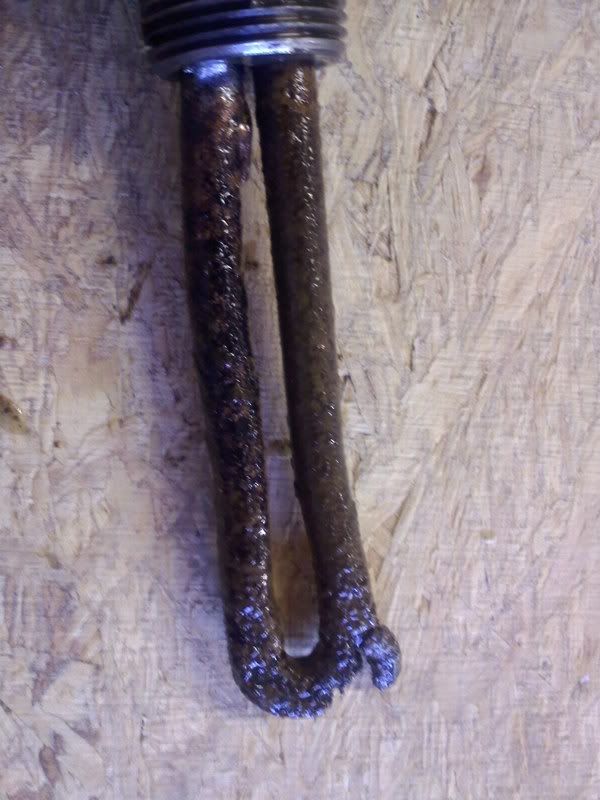
 I would never plug anything attached to my truck into a non-GFCI protected outlet!
I would never plug anything attached to my truck into a non-GFCI protected outlet!